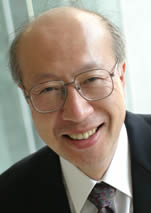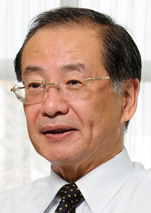2013 Recipients of C&C Prize
Group A

Dr. Kazuro Kikuchi Professor, the University of Tokyo |

Dr. Masataka Nakazawa Distinguished Professor, Tohoku University |
Citation
For Pioneering and Leading Contributions to the Advancement of Coherent Optical Fiber Communications Systems
Achievement
Since the mid-1990s, dense wavelength-division-multiplexed (DWDM) optical fiber transmission systems have been developed rapidly owing to the performance improvement of wideband erbium-doped fiber amplifiers (EDFA) and related technologies. As a result, a single-channel speed of 10 to 40 Gbps was achieved together with a total transmission capacity of up to the Tbps level over 100 DWDM channels and for system lengths of 1,000 to 10,000 km. Although such systems were put into practical use in around 2000, the need for transmission capacity increments of about 40% a year pushed the development of new breakthrough technologies that can increase a single-channel speed up to 100 Gbps. Since 2003, several technological breakthroughs have been proposed so as to (1) minimize the effects of fiber chromatic dispersion and polarization-mode dispersion and to (2) maximize the efficiency of frequency utilization within a limited EDFA bandwidth.
The most practical and desirable breakthrough technology was the multi-level digital coherent technology with quadrature phase shift keying (QPSK) and quadrature amplitude modulation (QAM). Dr. Kikuchi and Dr. Nakazawa made significant contributions to the fundamental development and realization of these new-generation technologies.
Dr. Kikuchi originally proposed an analog coherent fiber optic transmission system in 1980 with the late Prof. Takanori Okoshi. Although R&D activities for analog coherent systems had decreased due to the development of the EDFA, he continued his research. Then, in 2004, he proposed a digital coherent system as a next-generation system satisfying requirements (1) and (2) above for the first time in the world. His proposal was based on a homodyne optical receiver using phase and polarization diversities and digital signal processing. The output signals from the optical receiver were converted from the analog to digital domains and handled with a digital signal processor (DSP), where the chromatic dispersion and polarization-mode dispersion were compensated for and the received signals were demodulated effectively. Dr. Kikuchi reported experimental results of 40-Gbps signal transmission with a 2.5-bit/s/Hz frequency-utilization efficiency. This was the highest efficiency reported for 40 Gbps at that time. Since then, he has promoted the use of the digital coherent technology through numerous journal papers and conference presentations.
The biggest challenge for creating the digital coherent optical communications system was developing a higher-speed DSP. Initially, it was assumed that making a DSP that can operate from 40 to 100 Gbps would be very difficult. However, a transmission system provider in Canada developed a 40-Gbps DSP for dual-polarization QPSK signals and demonstrated its very high performance in compensating for chromatic dispersion and polarization-mode dispersion. This had a big impact on the fiber-optic communications field. In fact, digital coherent systems are now regarded as the mainstream technology for long-distance transmission at 40 to 100 Gbps.
Dr. Kikuchi has been a principal researcher in the field of coherent optical transmission since 1980. His theoretical and experimental accomplishments and creative proposals have been leading contributions to coherent optical fiber communications systems.
Dr. Nakazawa made distinguished contributions to multi-level digital coherent technologies. He proposed the world’s first system application especially for optical QAM transmission in 2006. In addition, he recently achieved experimental transmission for 1024-level QAM, which maximally utilized the optical phase and amplitude information.
He started his research in this area in 2000. That is when he developed a stable 1.5-micrometer wavelength erbium fiber laser having a narrow spectral width. It was tuned to an acetylene molecule absorption spectrum. His aim was to apply the laser for the signal and local light source for coherent QAM optical transmission. Using intermediate frequency (IF) stabilization circuits and a QAM optical modulator that he developed, he has experimentally performed many multi-level QAM transmission experiments. These include ones at the 64 and 128 levels in 2006, at the 256 to 512 levels in 2010 and 2011, and at 1024 in 2012. The frequency utilization efficiency has significantly improved from around 1 to 14 bit/s/Hz, which is very close to the Shannon limit spectral efficiency and is the world’s highest efficiency ever achieved in optical fiber transmission experiments. Although much improvement will be required to commercialize these QAM systems, he has achieved unrivaled and enlightening results in this research field.
In addition, he has long been known internationally for his numerous contributions to optical fiber communications. These include the world’s first achievement of a compact laser-diode-pumped EDFA in 1989 and the first demonstration of long-span optical-soliton transmission using compact EDFAs. Recently, he has also been known as a global advocate for the development of paradigm shift fiber optic transmission technologies, such as the use of a mulch-core fiber transmission or a multimode fiber transmission with multi-input/multi-output (MIMO) receiver technology.
Microwave technology may be considered to be a prerequisite for coherent optical transmission. However, to achieve extremely high-capacity and long-span transmission using optical fiber, various original and creative technologies have been required for the light sources, receiver diversity circuits, DSP control, optical fiber dispersion compensation, and so on. Nevertheless, both Dr. Kikuchi and Dr. Nakazawa have played very important roles in effectively developing coherent fiber optic communications systems.
The NEC C&C Foundation highly praises Dr. Kikuchi and Dr. Nakazawa for their contributions to the advancement of the information technology industry through their research and development on coherent optical fiber communications systems.
